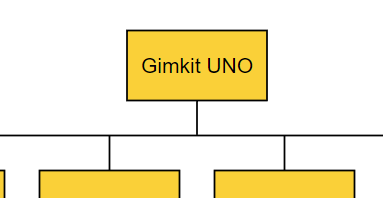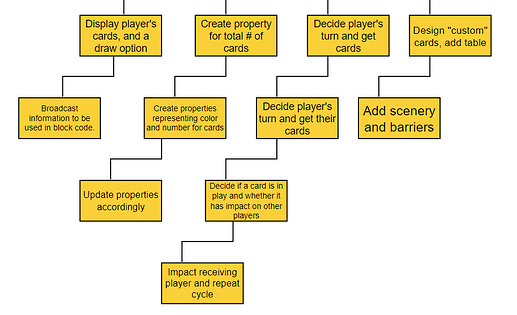This is the decomposition diagram website I used. I’m not gonna go into how to add text to a decomposition diagram, you could search that online, however, I want to focus on how useful they can be while expressing and creating future topics and ideas.
Creating a Gimkit game or system starting from nothing can be a bit difficult, especially when you have your goals in mind but they aren’t quite organized. However, decomposition diagrams can break down complex concepts into smaller, more manageable components. This simplifies the process and gives more room for creative liberties and engaging creations. Decomposition diagrams are essentially a visual roadmap that allows you to categorize and structure your ideas in a more organized and effective way. By dividing your game concept into parts, you can see the flow of the order of creating parts of your game or system, identify areas that require additional attention, and gives a cleaner creation and testing experience.
Layer #1
The first layer of your decomposition diagram for Gimkit game creation serves as the foundation of your game concept. This layer represents your chosen topic or theme around which the entire game or system will revolve. You should select a topic that aligns with what your game or system is about without being too descriptive.

Layer #2
This layer aims to break down Layer 1 into smaller, more manageable chunks while maintaining a level of broadness that leaves room for other more specific ideas. Layer 2 focuses on identifying important themes, concepts, or subcategories related to the main topic. This makes sure your game or system remains adaptable so you can tailor the experience to your skill level, learning style, or time constraints.
Layers #3 +
Layers 3 and beyond represent a further decomposition of the subcategories identified in Layer 2, breaking them down into even smaller components. Each layer delves deeper into the subcategories, providing a chronological order that creates a logical progression and flow of information that you would add to your game or system. Layer 3 and higher serve as the backbone of your game, defining the specific elements, facts, examples, or scenarios that players will encounter. With each new layer, the decomposition becomes more detailed, so you can create a comprehensive Gimkit game or system that is more properly created.
Using decomposition diagrams or even other charts can help your ideas stay organized and helps give you a list of goals you need to complete next, which could speed up the process of creating!
(I’m not gonna make Gimkit UNO, if you want to make UNO or make a guide about it, that’s up to you. Some information in the chart might not be accurate because I’m not making Gimkit UNO.)

